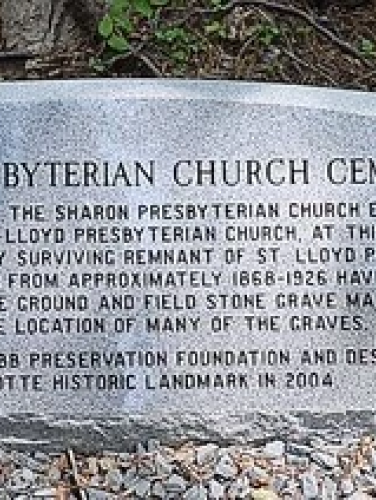
Saint Lloyd Presbyterian Church Cemetery
(ca. 1868)
The St. Lloyd Presbyterian Church Cemetery is a rare extant reminder of the rural African American farming communities that arose after the abolition of slavery.
3711 Colony Rd, Charlotte, NC 28211
The St. Lloyd Presbyterian Church Cemetery is the only surviving remnant of the once thriving St. Lloyd Presbyterian Church, a Christian congregation established in 1868 by the newly emancipated Black residents of Mecklenburg County’s Sharon township. Following their liberation from enslavement, many within the county’s Black population sought to disassociate from White congregations, whose churches typically required the former bondspeople to sit in the balconies or other segregated areas within sanctuaries during worship services. In October 1867, a group of African American members of Sharon Presbyterian Church petitioned the church elders for assistance in establishing their own house of worship. It is believed that those petitioners were some of the original members of what became St. Lloyd Presbyterian Church.
Property Quick Links
Reverend Willis L. Miller – a cofounder of Biddle Institute (now Johnson C. Smith University) and the Catawba Presbytery, the first all-Black presbytery in the United States – assisted the charter members of St. Lloyd establish their church. In February 1868, five St. Lloyd trustees purchased one acre of land for $25 for the congregation’s first church building. The property was located approximately one mile north of Sharon Presbyterian Church’s current location. Most St. Lloyd members were impoverished. They worked primarily as farmers, manual laborers, and domestic help. The church served as a religious and social center for the community.
The St. Lloyd property on Colony Road was sold in 1926 to former North Carolina governor Cameron Morrison (1869-1953) and his wife Sarah (1867-1950) for incorporation within their 3,000-acre experimental farm known as “Morrocroft.” The sale of the property facilitated the St. Lloyd congregation’s move to the primarily African American neighborhood of Grier Heights, on what is now Wendover Road. The move was related to broader trends present in Charlotte and Mecklenburg County during the “Jim Crow” era. Following Reconstruction, neighborhoods like those in the Sharon township that for many years showed a “salt and pepper” pattern – where Black and White Charlotteans lived, worshipped, and worked in close proximity – became increasingly segregated. As a result, several Black churches like St. Lloyd relocated to the communities more closely aligned with their memberships.
At least seventy-eight graves dating from approximately 1868 until 1926 have been identified in the St. Lloyd Presbyterian Church Cemetery. Few grave markers remain. Those that have survived are field stones with no inscriptions. As a result, most of the graves have been located based upon ground depressions measuring approximately two feet wide by four to six feet long. No visible evidence of the church building remains, leaving this small cemetery as one of the few reminders of the Sharon rural farming community of emancipated African Americans that was later to be replaced by one of the most highly developed sections of Charlotte.

